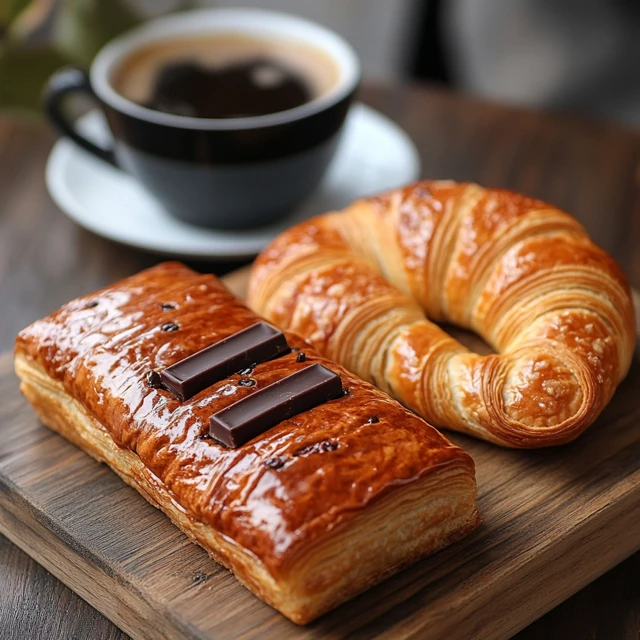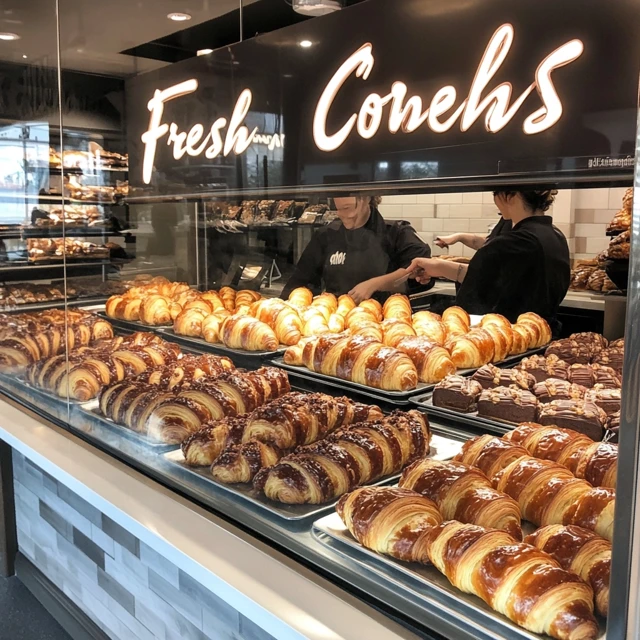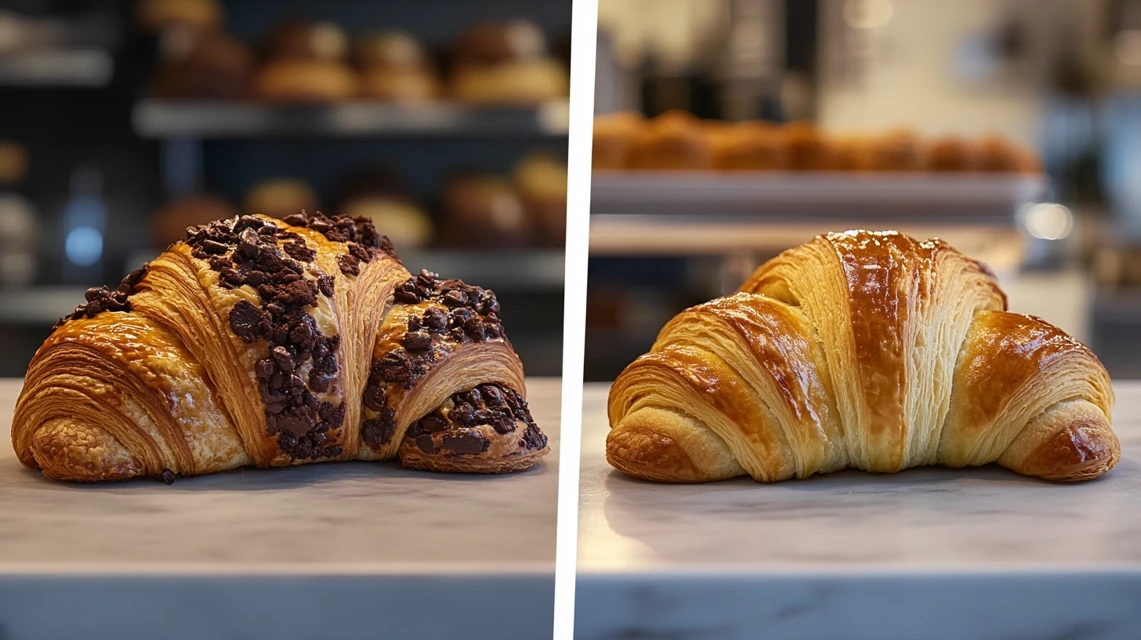Americans call this flaky chocolate pastry a chocolate croissant, but French people know it as pain au chocolat. This difference in names often gets pastry fans talking and debating. So why do Americans use a different name? Let’s look at where the name came from, how culture changed it, and how marketing helped spread it across the U.S.
Understanding the Name Difference
People call the same pastry chocolate croissant or pain au chocolat because of history, culture, and language differences. Even though these treats look and taste the same, their different names show how food changes as it moves from one place to another.
check out this https://eassyrecipes.com/category/breakfast/
Origin of the Term ‘Chocolate Croissant’ in the U.S.
Americans first started saying chocolate croissant to make French pastry names easier to understand. Back in the 1900s, when more Americans began to love French food, bakeries needed simple names for their treats. After all, most customers didn’t know French words, so they picked names that made sense to everyone.
Croissants were already well-known in the American market, thanks to their crescent shape and buttery texture. Thus, the name chocolate croissant was a logical adaptation, combining the familiarity of croissants with the delicious addition of chocolate.
Additionally, as American bakeries began producing their own versions, they often shaped them more like the traditional crescent croissant rather than the rectangular pain au chocolat, further reinforcing the name change.
check out this https://eassyrecipes.com/category/breakfast/
How French Culinary Terms Are Adapted in America

In the U.S., many French culinary terms have been simplified or anglicized to make them more accessible to the general public. Americans tend to favor straightforward, descriptive names that immediately convey what the food is.
For example:
- Baguette becomes “French bread.”
- Éclair is often referred to as “chocolate cream pastry.”
- Crème brûlée is commonly known as “burnt cream dessert.”
In the same way, pain au chocolat, which translates to “chocolate bread,” may not have resonated with American consumers who are more accustomed to referring to pastries based on their shape and ingredients. The term chocolate croissant provides a clear, visual association with the popular crescent-shaped pastry they already knew and loved.
check out this https://eassyrecipes.com/category/breakfast/
Differences in Pastry Culture Between the U.S. and France
French people deeply value their pastries and want to protect the traditional names. So, they proudly use pain au chocolat to show respect for the original recipe and the skilled bakers who first made it. For them, these names connect to their history and culture.
Meanwhile, American bakeries focus more on making pastries easy to buy and understand. They want everyone to feel comfortable ordering their treats, so they pick simple names that sound familiar. That’s why they changed many French pastry names, including pain au chocolat, to words that Americans already know.
Moreover, American bakeries often experiment with flavors and shapes, creating variations that differ from the original French versions. For example, some U.S. bakeries offer crescent-shaped chocolate croissants filled with chocolate chips or drizzled with chocolate sauce, deviating from the traditional French style.
The Influence of Marketing and Consumer Preferences

Companies carefully choose food names that will help sell their products. In fact, marketers found that Americans preferred and bought more pastries labeled as chocolate croissant instead of pain au chocolat. So, they stuck with the English name.
The Role of American Bakeries in Popularizing the Name
When French pastries first gained popularity in the U.S., bakeries needed a way to make them more appealing to American customers. Recognizing that the word “croissant” was already familiar and associated with breakfast, they added the term “chocolate” to clearly describe the filling.
Major bakery chains and coffee shops, such as Starbucks and Panera Bread, adopted the term chocolate croissant to simplify their menus and attract customers who might not be familiar with French pastries. Over time, this branding choice reinforced the use of the term across the country.
The availability of chocolate croissants in pre-packaged forms in supermarkets further solidified the name. Consumers looking for a convenient treat would likely opt for a product with a name they could easily recognize and pronounce.
Why ‘Chocolate Croissant’ Is More Appealing to Customers
For many American consumers, the term chocolate croissant is more appealing because it is:
- Descriptive: The name clearly indicates the two main components—croissant and chocolate—making it easier for customers to know what to expect.
- Familiar: Croissants are a common breakfast pastry in the U.S., so adding chocolate simply builds on an existing favorite.
- Easy to Pronounce: Unlike pain au chocolat, which may be difficult for some Americans to pronounce, chocolate croissant rolls off the tongue more easily.
These factors make the pastry more accessible to a wider audience, driving sales and popularity.
Impact of Globalization on Pastry Terminology
As food travels around the world, people often change the names to match their own language and culture. So now, many countries besides the U.S. call them chocolate croissants too, because it’s easy to understand.
Big chains like McDonald’s and Starbucks, plus hotels and bakeries worldwide, started using the name “chocolate croissant” everywhere. First, they used it in English-speaking places, and then it spread. Now, even people who love French food often say chocolate croissant because it helps everyone understand what they mean.
Furthermore, social media and food blogs have popularized the term, influencing younger generations to adopt it instead of the more traditional French name.
Differences Between Chocolate Croissants and Pain au Chocolat
Many people think that chocolate croissants and pain au chocolat are the same. However, they have some key differences. These differences include their shape, texture, and cultural significance. Let’s explore what makes them unique.
Shape and Texture Variations
The most noticeable difference between these pastries is their shape.
- Chocolate Croissant:
- Shaped like a crescent.
- Made by rolling the dough into a triangle and folding it.
- The outer layers feel light and crispy.
- The inside stays soft and airy.
- Pain au Chocolat:
- Shaped like a rectangle or square.
- The dough wraps around chocolate batons.
- The texture is denser and more uniform.
- The layers create a satisfying bite with each mouthful.
Because of these differences, croissants often feel lighter, while pain au chocolat gives a firmer texture with consistent chocolate in every bite.
Chocolate Filling Differences
Both pastries contain chocolate, but the type and placement vary.
- Chocolate Croissant:
- Some versions use chocolate chips or spread.
- Chocolate may not be evenly distributed.
- Sweet milk chocolate is often used.
- Pain au Chocolat:
- Always filled with chocolate batons.
- The filling stays in the center of the pastry.
- Dark chocolate is the preferred choice.
Pain au chocolat offers a more balanced taste with rich, slightly bitter chocolate. In contrast, chocolate croissants can taste sweeter and sometimes uneven due to the spread or chips.
Cultural Significance of Both Pastries
Each pastry holds different meanings in their respective cultures.
- In France:
- Pain au chocolat is a classic breakfast choice.
- People buy it fresh from bakeries daily.
- It is part of French tradition and culinary pride.
- Some regions even call it chocolatine.
- In the U.S.:
- Chocolate croissants are often eaten as a treat or dessert.
- They are widely available in supermarkets and coffee shops.
- Many see them as a luxurious snack rather than a breakfast staple.
- Bakeries experiment with different flavors, like almond or caramel.
Pain au chocolat carries strong ties to French heritage. In the U.S., the pastry focuses more on convenience and indulgence.
FAQs About Chocolate Croissants
Here’s how I’d combine all of those pieces under the key phrase:
Why Do Americans Call It A Chocolate Croissant? People around the world love chocolate croissants, or pain au chocolat. You might wonder about where this tasty pastry comes from and why it has different names. Let me tell you more about this beloved breakfast treat.
Why Do Americans Call Pain au Chocolat a Chocolate Croissant?
Why Do Americans Call It A Chocolate Croissant? Well, the story starts in Austria. Back in the 1800s, French bakers got the idea for croissants from an Austrian pastry called kipferl. Then they made it their own. Today, Americans say chocolate croissant because it makes more sense to them. Since most people in the U.S. already know what a croissant is, adding the word “chocolate” helps them quickly understand what they’re getting.
French names like pain au chocolat can be tricky for some people to pronounce. Bakeries in the U.S. chose the simpler name to attract more customers. Over time, this name became more common and accepted.
Another reason is the shape. Some American bakeries make their chocolate-filled pastries in the classic crescent shape, making the term “croissant” more fitting.
What Is the Meaning of Chocolate Croissant?
A chocolate croissant refers to a pastry made from flaky, buttery dough filled with chocolate. It combines the texture of a croissant with a sweet chocolate filling.
In the U.S., the term describes a crescent-shaped pastry, while in France, it refers to the rectangular pain au chocolat.
Essentially, the name represents a delicious pastry enjoyed for breakfast or as a snack.
What Is the Real Name for Chocolate Croissants?
The correct name for a chocolate croissant is pain au chocolat. This French term means “chocolate bread” and is the authentic name for the pastry.
In parts of southern France, some people call it chocolatine, sparking debates over the correct term. Despite the different names, they all refer to the same pastry—a buttery delight with a chocolate center.
Although chocolate croissant is commonly used in English-speaking countries, French bakeries always stick to the traditional term.
Who Invented the Chocolate Croissant?
Why Do Americans Call It A Chocolate Croissant? Well, the story starts in Austria. Back in the 1800s, French bakers got the idea for croissants from an Austrian pastry called kipferl. Then they made it their own.
French bakers refined the recipe, creating the flaky layers known today. The idea of adding chocolate came later in the early 20th century when bakers started placing chocolate sticks inside the dough.
Over time, pain au chocolat became a staple in French bakeries and spread worldwide.
Conclusion
The chocolate croissant, or pain au chocolat, has a fascinating history and cultural variations. Americans use the term “chocolate croissant” because it is easier to understand and market. Whether you call it pain au chocolat, chocolatine, or chocolate croissant, it remains a beloved pastry enjoyed by people everywhere.

